We may earn revenue from the products available on this page and participate in affiliate programs. Learn More ›
Dr. John R. Drish House in Tuscaloosa, Alabama

Wikimedia Commons via Carol M. Highsmith
This elaborate plantation house, a distinctive melding of the Greek Revival and Italianate styles, was built in 1837. Slave artisans executed the house’s ornate woodwork and plasterwork, yet its infamy extends beyond the slave labor used to build it: The house is believed to be haunted, and people have reported ghostly lights coming from the house.
Related: 15 Places Every American Should Visit at Least Once
Begich Towers in Whittier, Alaska

flickr.com via Travis
Gossip travels fast and furiously in a small town, but imagine what happens when everyone’s under same roof! That is exactly the living situation of the residents of Begich Towers in the small town of Whittier, Alaska. Built in 1953 as part of a large military complex that was never completed, the building now houses most of the town’s population of 215 people.
Related: 25 Tiny Towns to Visit for a Glimpse at How We Used to Live
The Rosson House in Phoenix, Arizona

Wikimedia Commons via Greg O’Beirne
This 1895 Queen Anne Victorian was built for Dr. Roland Rosson, a prominent physician and politician. It changed hands several times over its long life, evolving into a rooming house that was eventually subdivided into individual units until it fell into disrepair and became little more than a flophouse. The city of Phoenix purchased the building in 1974. Through community efforts, it was restored and turned into a historic house museum, sitting on its original foundation in the middle of bustling downtown Phoenix.
Allen House in Monticello, Arkansas

Zillow Digs home in Monticello, Arkansas
Built in 1906 for a family with three daughters, this Queen Anne Victorian is said to be haunted by one of the daughters, who died in 1948 after ingesting poison. Upon her daughter’s death, her mother boarded up her room, leaving it untouched for 40 years. The house is now a private residence but is available for tours and special events.
Winchester Mystery House in San Jose, California

Wikimedia Commons via Spiel
This rambling, unorthodox mansion was once the home of Sarah Winchester, heiress to the Winchester firearm fortune, who oversaw around-the-clock construction on the property until her death in 1922. With neither an architect nor a plan, the house was built haphazardly, resulting in architectural curiosities such as stairs that lead to nowhere and windows that look into other rooms.
Related: The 20 Friendliest Cities in America
Croke-Patterson Mansion in Denver, Colorado

One of Denver’s oldest homes, the Croke-Patterson Mansion is also said to be one of the most haunted. The alleged hauntings were documented in “The Castle Project,” a 2011 film that follows eerie occurrences during the building’s conversion into a bed-and-breakfast. Workers at the time reported otherworldly phenomena, including ghostly apparitions, strange voices, and sudden changes in temperature.
New London Ledge Lighthouse in Groton, Connecticut
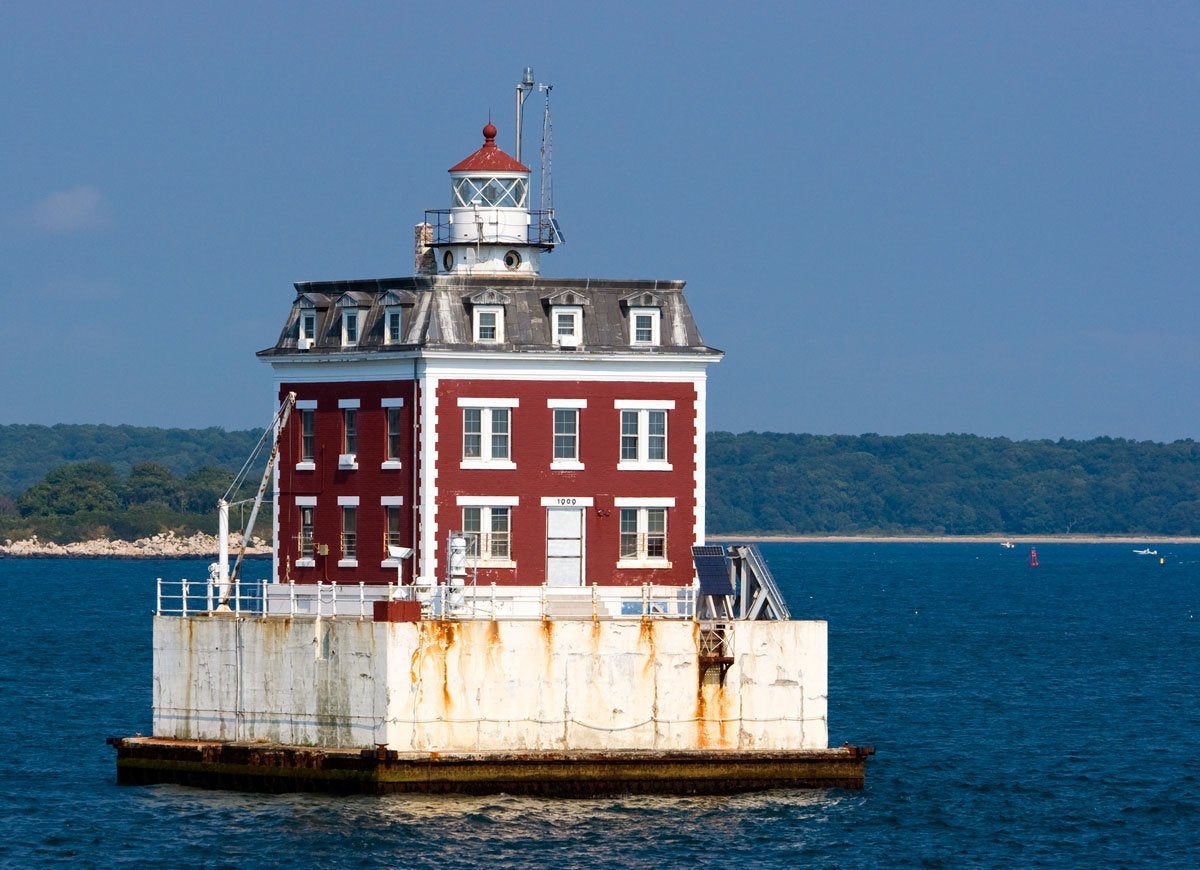
Perched all alone in the waters of Fishers Island Sound, this three-story granite lighthouse is said to be haunted by the ghost of a former keeper named Ernie, who allegedly jumped from the roof after his wife ran away with a ferry captain. The forlorn ghost of Ernie is rumored to turn radios and televisions on and off, untie boats, and sound the foghorn on clear days.
Related: You’ll Never Believe What These 6 Homes Used to Be
Governor's House in Dover, Delaware

flickr.com via Jeffrey
A beautiful example of mid-Georgian period architecture, this property, also known as Woodburn, was constructed in 1790 and played host to a number of notable locals before becoming the official residence of the governor in 1965. The house earns a spot on our list of infamy for suspected paranormal activity.
Al Capone House in Miami Beach, Florida

Al Capone paid for this Florida mansion in 1928 with $40,000 in cash and, except for a stint in jail for tax evasion, lived there until his death in 1947. The mobster’s home improvements included a two-story cabana, which he used to house his personal bodyguards.
Mercer Williams House in Savannah, Georgia

This Italianate house, completed in 1868, rose to infamy as the scene of the murder recounted in the book “Midnight in the Garden of Good and Evil.” The property, which is, not surprisingly, said to be haunted, is open to the public for tours.
‘Iolani Palace in Honolulu, Hawaii

This ornate confection served as the residence of the rulers of the Kingdom of Hawaii from 1845 until 1893, when the monarchy was overthrown. It was the state capitol until 1969 and was then reopened as a museum in 1978.
Related: Island Living: 20 Tropical B&Bs That Are Only an Airplane Away
Standrod Mansion in Pocatello, Idaho

Wikimedia Commons via Library of Congress
Built in 1902 in the Chateauesque style, this majestic turreted castle was once home to the prominent Standrod family. Their 16-year-old daughter, who died tragically, is said to haunt the two-story sandstone house.
Related: 20 Beautiful Homes Hiding in America’s Most Affordable Cities
McPike Mansion in Alton, Illinois

Wikimedia Commons via Mcpikemansioncrew
Perched atop the highest point in Alton, this once-splendid 19th-century country house has been abandoned since the 1950s and is a popular attraction for ghost hunters. Now lost to vandalism, the mansion at one time featured marble fireplaces
and ornate carved stairways.
Whispers Estate in Mitchell, Indiana

YouTube via The Weekly Special – WTIU
Whispers Estate, where some say the walls really do talk, is considered one of the most haunted homes in Illinois. No one lives in the impressive Victorian
today, but it is available for rentals and events.
Related: 16 Iconic American Homes Torn Down Before Their Time
The Villisca Ax Murder House in Villisca, Iowa

flickr.com via Laura Bernhardt
This unassuming home became infamous as the site of a bloody, tragic multiple murder one night in 1912. The crime was never solved and remains a source of local fascination. Those who are curious about the mysterious crime can visit the house, which is open for tours, and make their own investigations.
"In Cold Blood" House in Holcomb, Kansas

Made famous by a murder case that captivated the country in the 1960s, this home was once the property of a prominent farming family. Immortalized in “In Cold Blood,” Truman Capote’s “nonfiction novel,” the house may never shake its grisly reputation.
Liberty Hall in Frankfort, Kentucky

flickr.com via J. Stephen Conn
Once home to one of the first senators of Kentucky, today Liberty Hall is on the National Register of Historic Places. In addition to being a popular site for weddings and other events, it is said to play host to three restless ghosts.
The Myrtles Plantation in St Francisville, Louisiana

Wikimedia Commons via Bogdan Oporowski
This historic antebellum plantation is touted as one of the most haunted places in the country, thanks to the number of deaths—both natural and violent—that have occurred on the property. The sprawling Creole cottage-style home was named for the crepe myrtle trees that grow in the vicinity.
Olson House in Cushing, Maine

flickr.com via Neal Wellons
This 14-room Colonial farmhouse, built in the 1700s, has been seared into the American consciousness thanks to its depiction in painter Andrew Wyeth’s masterpiece “Christina’s World.” In the painting, Wyeth portrays Christina Olson, who had lost the use of her legs, crawling through a field toward the house.
Hager House in Hagerstown, Maryland

Wikimedia Commons via Acroterion
The two-story stone structure, now a historic house museum, dates to 1740 and was built by Jonathan Hager, a German immigrant who founded Hagerstown, Maryland. The basement contains two spring-fed pools of water and, according to believers in the paranormal, the house shelters more than one ghost.
Lizzie Borden House in Fall River, Massachusetts

Wikimedia Commons via DkEgy
Lizzie Borden took an axe… and, well, you know the rest. The famous site of the 1892 “forty whacks” murder of Borden’s father and stepmother has become a national legend. Despite Borden’s sinister reputation, she was never convicted and vacated the house after the crime. The site of the murders is now a bed-and-breakfast for those brave enough to enter.
Henderson Castle in Kalamazoo, Michigan

flickr.com via gab482
Michigan is said to be full of haunted houses, but Henderson Castle is one of the most infamous. The 1895 Queen Anne castle reflects the most elegant tastes of the time, with 25 rooms, seven bathrooms, a ballroom, and an elevator. Located atop a hill overlooking downtown Kalamazoo, the property is now a bed-and-breakfast that accommodates paranormal enthusiasts and nonbelievers alike.
Glensheen Historic Estate in Duluth, Minnesota

flickr.com via jpellgen
Located on 12 acres on the waterfront of Lake Superior, this 20,000-square-foot mansion was built in 1908 in the Jacobean architectural style. The sprawling residence, a stellar example of Midwestern craftsmanship, may be as spooky as it is beautiful: The site of a double homicide in 1977, the house is believed to be haunted.
Related: The Cost of 2,000 Square Feet in America’s Cheapest Cities
Beauvoir in Biloxi, Mississippi
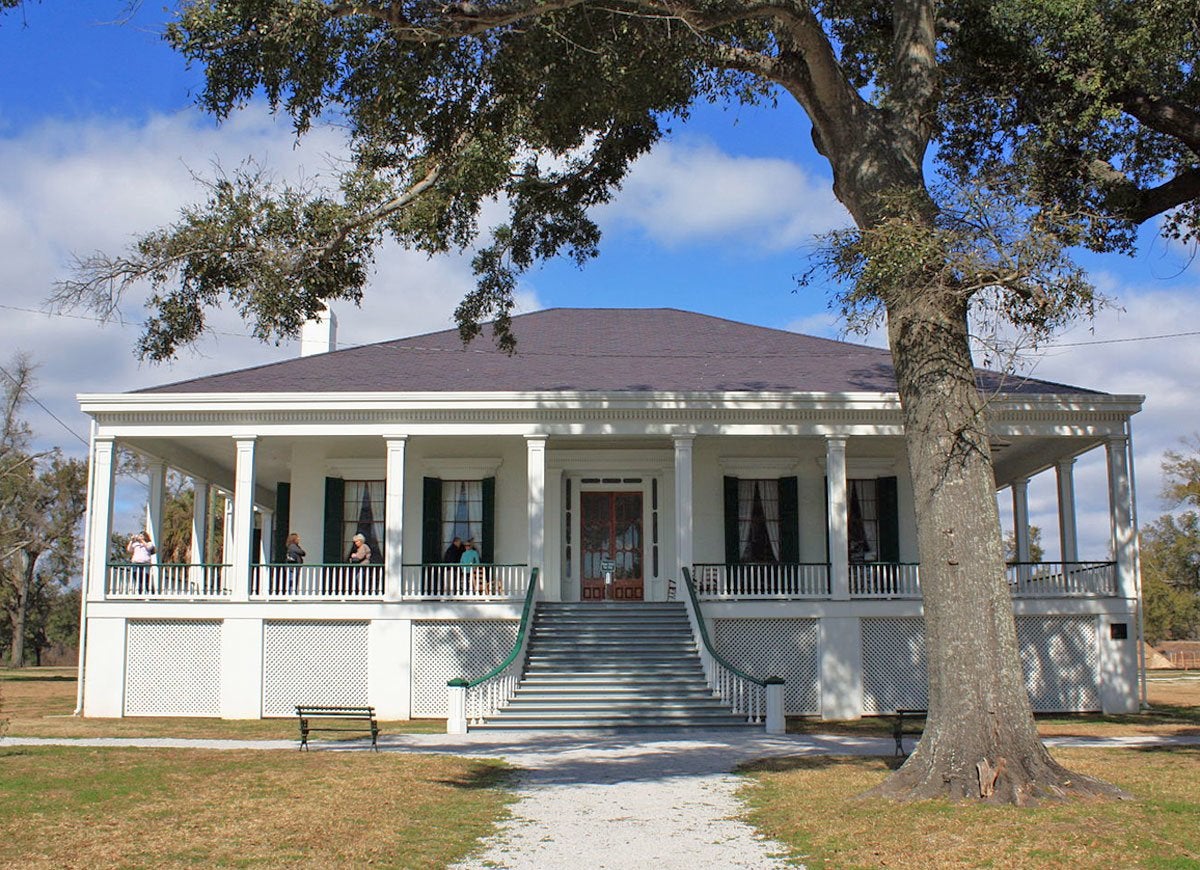
This estate is notable as the retirement home of Jefferson Davis, the President of the Confederate States of America. Located on the Gulf Coast, the 1852 structure has survived several hurricanes and now houses a library of Civil War documents and books about Southern history.
Related: 20 Places with (Almost) Zero Crime
Jesse James House in St. Joseph, Missouri
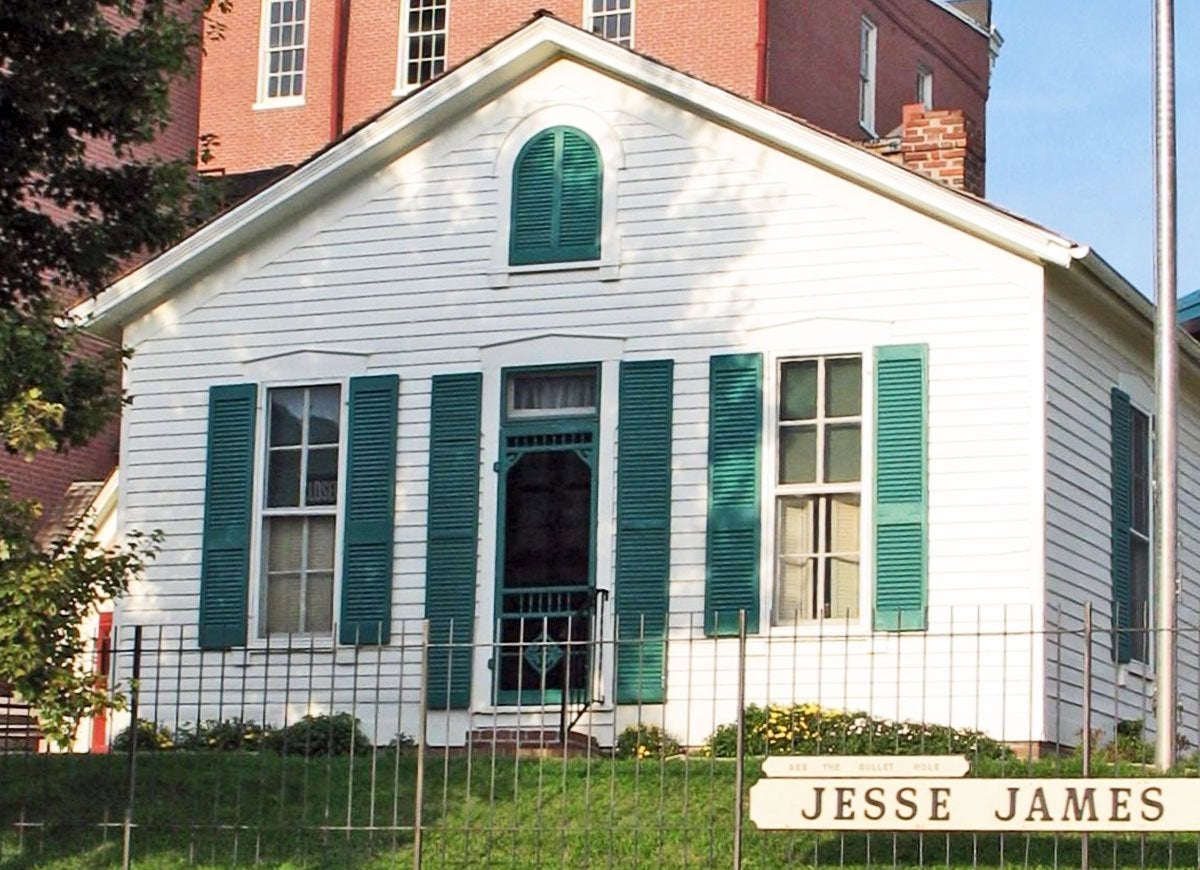
Notorious outlaw Jesse James was shot in the back by a former member of his gang in this house in 1882, where he was living under an assumed identity with his wife and children. The Greek Revival house is now a museum dedicated to its ne’er-do-well owner.
Shelter Island House in Rollins, Montana

Zillow Digs home in Rollins, Montana
If the $17.75 million price tag on this 18,646-square-foot home on Flathead Lake in Montana seems steep, consider that it was listed at $78 million as recently as 2012. With an indoor shooting range and heated boat stall, this 22-acre estate on a private island is too grand for its own good.
Related: How Much!? You Won’t Believe the Price of These Teeny Tiny Apartments
Captain Bailey House in Brownville, Nebraska

flickr.com via Ali Eminov
This 19th-century Gothic Revival house was built for Benson M. Bailey, a Civil War captain who was poisoned by an enemy and is rumored to still haunt his home. Now a historic house museum, it was moved brick by brick to its present location in Brownville, Nebraska, after the nearby Missouri River changed course enough to endanger the original site.
Bliss Mansion in Carson City, Nevada

The 8,500-square-foot home of millionaire Duane L. Bliss was once the largest and grandest in the state. Built over a former cemetery (the bodies were moved to make way for construction), this mansion has long had a reputation for playing host to ghosts.
Robert Frost Farm in Derry, New Hampshire

Wikimedia Commons via Craig Michaud
Robert Frost called this Derry, New Hampshire, farmhouse home between 1900 and 1911. A letter Frost wrote in 1952 documents that the property served as a source of inspiration for several of his renowned works. “The only thing we had was time and seclusion,” Frost wrote. “I couldn’t have figured on it in advance. I hadn’t that kind of foresight. But it turned out right as a doctor’s prescription.”
Watcher House in Westfield, New Jersey

Zillow Digs home in Westfield, NJ
“Watcher House” sounds like the title of a horror movie, and, appropriately, the history of this so-named home in New Jersey reads like a movie script. After the current owners bought the home in 2014, they received a series of sinister and threatening letters that made it appear that the house was being stalked by a stranger. The owners have listed the home for sale since then, but even after multiple price reductions (and a lawsuit against the former homeowners), it still has no takers.
The Breaking Bad House in Albuquerque, New Mexico
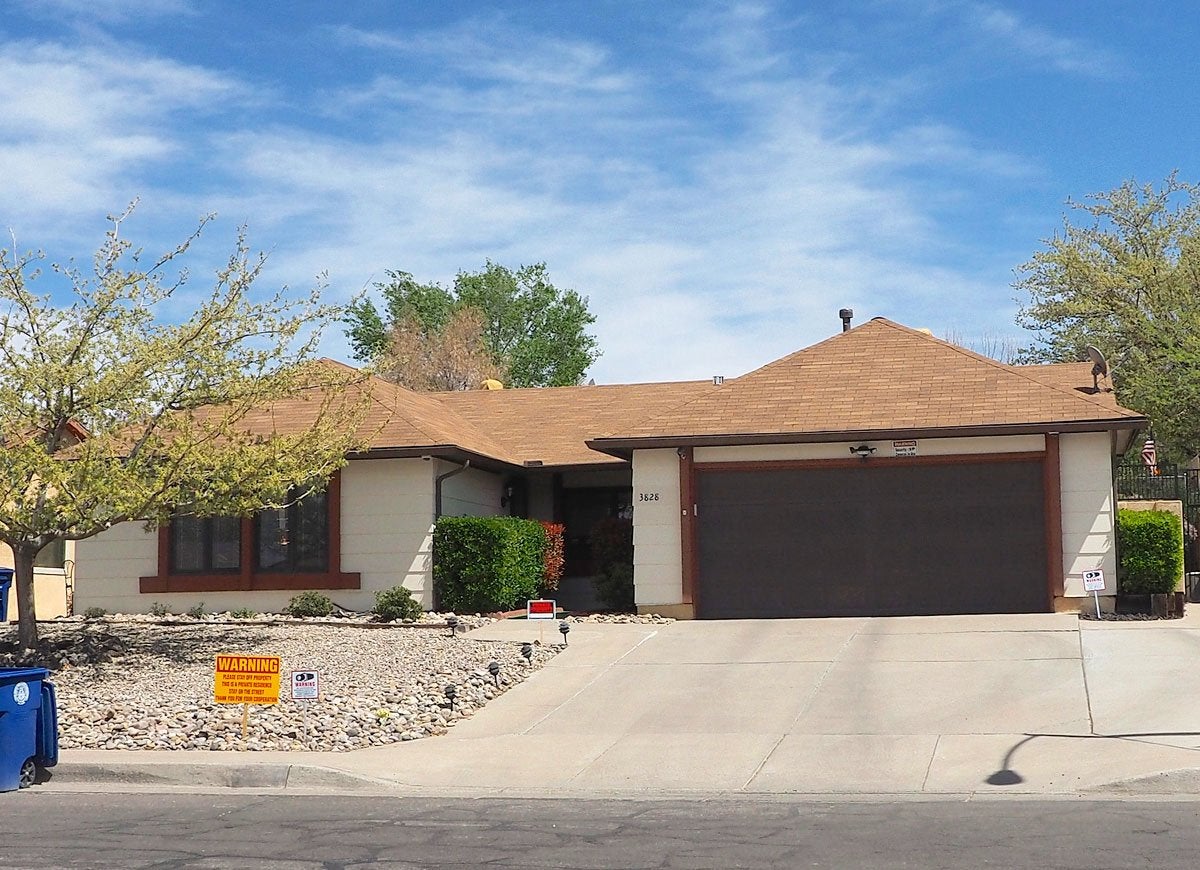
flickr.com via Clay Gilliland
Before turning to a life of crime, Walter White of “Breaking Bad” lived a peaceful life in a typical Albuquerque home. But peace isn’t exactly what real-life homeowner Joanne Quintana has been experiencing, even years after the show’s final season. In response to the antics of overzealous fans who have come out in droves, taking photos, trespassing, and even throwing pizzas on the roof in a nod to a memorable scene from Season 3, she recently installed a 6-foot-high fence around the property.
Related: What 11 Ordinary People Paid to Live in Your Favorite Movie Home
Amityville Horror House in Amityville, New York

flickr.com via murdoc
This stately home that served as the backdrop for a gruesome mass murder sits in the town of Amityville on Long Island in New York. The horrifying crime inspired a popular book, several sequels, and a number of movies that chronicled alleged paranormal events that transpired after the murders, cementing the home’s
place in haunted house history.
North Carolina Executive Mansion in Raleigh, North Carolina

The Executive Mansion of Raleigh, North Carolina, was built in 1891 to house the governor and serve as a meeting space. To keep costs down, inmate labor was used wherever possible; look closely, and you’ll see that some of the bricks bear the names of the men who made them.
Fort Mandan in McLean County, North Dakota
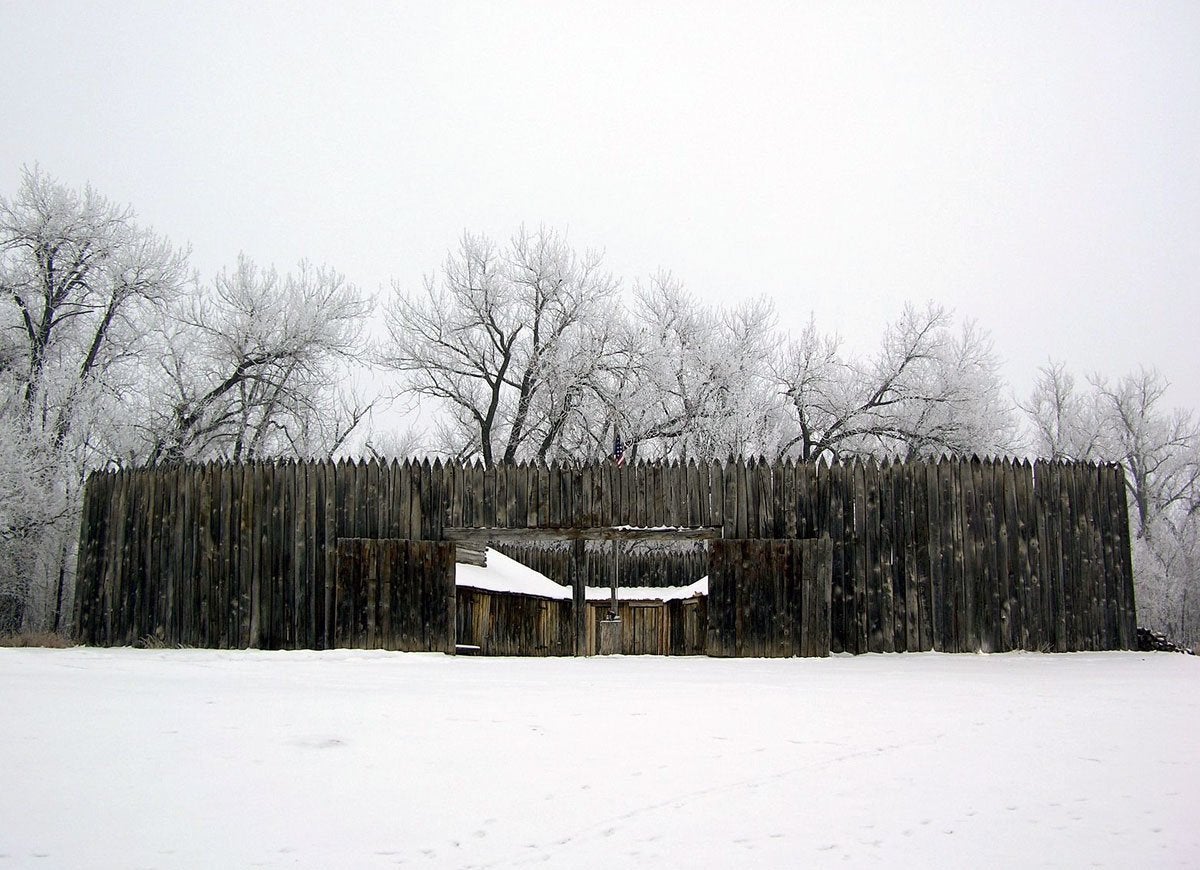
Wikimedia Commons via Gooseterrain2
Fort Mandan served as the winter encampment of the Lewis & Clark Expedition from 1804 to 1805. It was at this site that Lewis and Clark prepared detailed reports on things that they had done and people they had met on their famous journey westward. The current structure, a reproduction, is open to the public.
Related: 15 Places Every American Should Visit at Least Once
Franklin Castle in Cleveland, Ohio

Wikimedia Commons via Cricchetti
Located on Franklin Boulevard in Cleveland, Ohio, Franklin Castle is still standing strong after more than 125 years. The house was built by German immigrant Hannes Tiedemann as both a home for his family and temporary housing for others emigrating from Germany. Today, however, it’s best known for its alleged hauntings.
Related: The 20 Friendliest Cities in America
Westhope in Tulsa, Oklahoma

flickr.com via Joffre Essley
Frank Lloyd Wright designed this Tulsa home in 1929 for his cousin, Richard Lloyd Jones. Though Wright is considered one of the most iconic architects in American history, the house had one serious flaw: The flat roof tended to leak, which caused Jones’s wife, Georgia, to muse famously one day during a downpour, “This is what we get for leaving a work of art out in the rain.”
Related: The 12 Most Infamous Goofs in Architectural History
The Flavel House in Astoria, Oregon
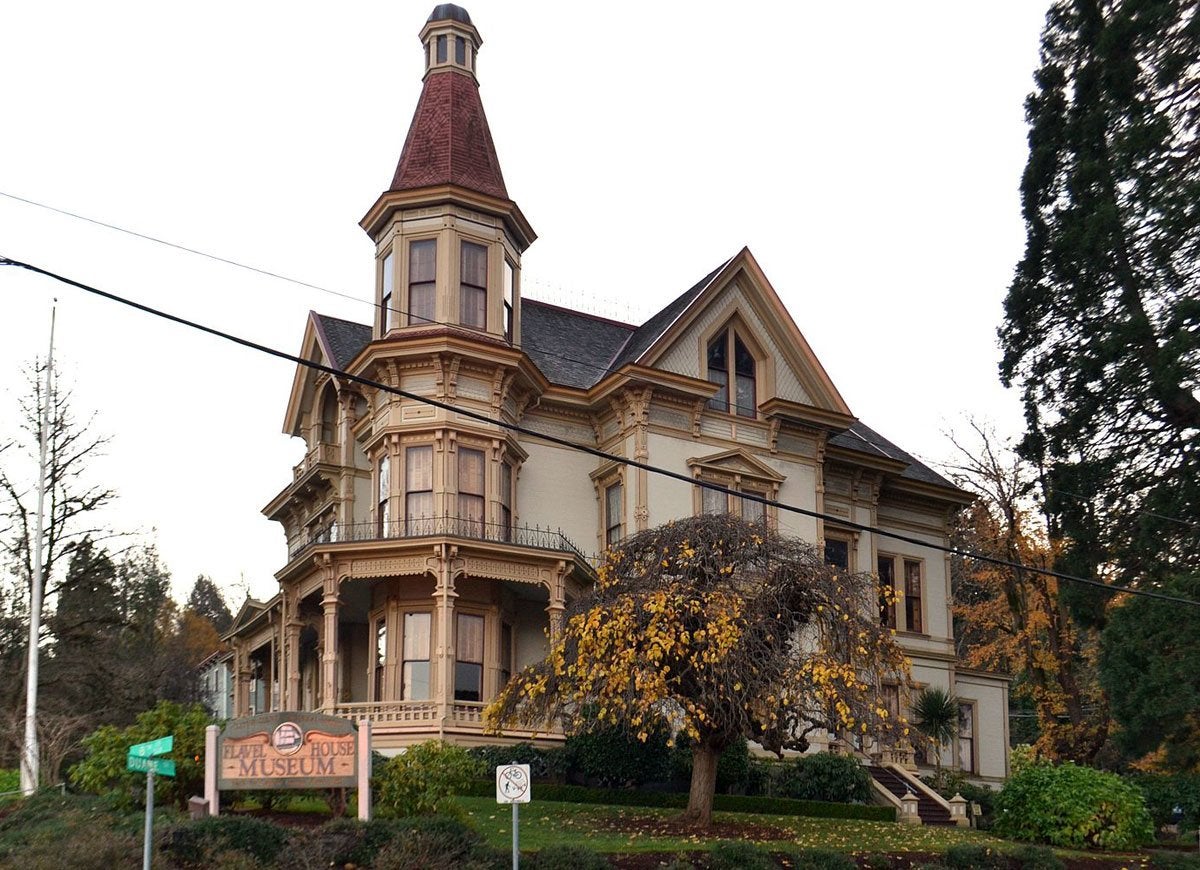
Wikimedia Commons via Visitor7
This two-and-a-half story, 11,600-square-foot Queen Anne occupies an entire city block in Astoria, Oregon. Built in 1886 for Captain George Flavel, a river bar pilot and prominent local businessman, the home has beautifully withstood its trying history. Having survived a fire that claimed most of downtown Astoria in 1922, the house was then nearly bulldozed twice to make way for recreational space and a parking lot. Both times the community rallied to save the building, which is now a historic house museum, from an untimely fate.
Related: 16 Iconic American Homes Torn Down Before Their Time
Angelo Bruno's Rowhouse in Philadephia, Pennsylvania

Google Maps
The home of Philadelphia mob boss Angelo Bruno became well known after his much-publicized assassination in 1980, but that notoriety wasn’t enough to earn this home a spot on the city’s list of historic landmarks. Although the house was nominated in 2016, the Committee on Historic Designation determined that Bruno. while certainly infamous, wasn’t significant enough for the house to warrant designation.
Governor William Sprague Mansion in Cranston, Rhode Island

The birthplace of two Rhode Island governors (Governor William Sprague III, and Governor William Sprague IV), this home was added to the National Register of Historic Places in 1971. Since then, it has been the site of a controversy involving two 19th-century cannons displayed on the property that were used by Governor William Sprague IV’s regiment in the Civil War. Both the Cranston Historical Society and Rhode Island National Guard claim ownership of the historic weaponry, although the two sides have reached a detente that allows the cannons to remain on the grounds—for now.
Related: 17 Things You Won’t Believe People Actually Collect
Burt-Stark Mansion in Abbeville, South Carolina
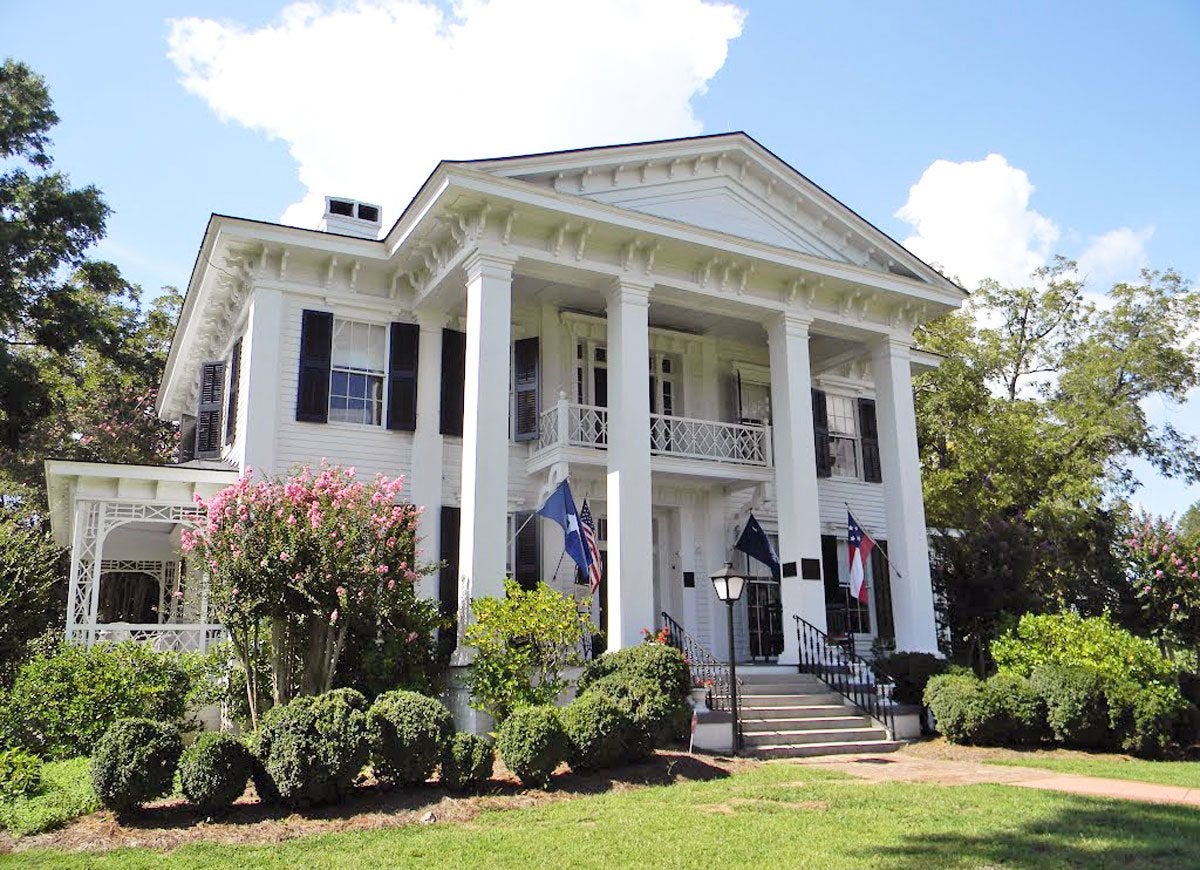
Wikimedia Commons via Upstateherd
It was at the Burt-Stark Mansion in 1865 where Confederate President Jefferson Davis was convinced by his cabinet that it was futile to keep fighting. The Greek Revival residence and its contents were donated to the local preservation commission by its last owner, Mary Stark Davis.
Adams House in Deadwood, South Dakota

The gold rush town of Deadwood is regarded by locals as haunted, and the Adams House is perhaps one of the most well-known “ghostly” properties in the area. It was state of the art in 1892, with electricity, indoor plumbing, and telephone access, but it was abandoned by its mistress after the death of her husband, who is said to haunt the home.
The Hermitage in Nashville, Tennessee

Wikimedia Commons via Jim Bowen
Also known as “Home of the People’s President,” Andrew Jackson’s residence, the Hermitage, sits on a 425-acre farm. Originally built in the Federal style, it was given a Greek Revival renovation after a fire destroyed much of the home in 1834. The house, which some believe is haunted, is open throughout the year for ghost tours.
Beer Can House in Houston, Texas

Wikimedia Commons via Andrew Wiseman
A retired upholsterer, John Milkovisch of Houston, Texas, had completely filled up his yard with handmade landscape features he created from marbles, rocks, metal, and concrete. The next logical step? Adding beer can siding to his home—roughly 50,000 cans in all. Though the original residents have gone, today the “Beer Can House” is a permanent exhibit of the Orange Show Center for Visionary Art.
Related: Weird or Wonderful: 22 Homes That Are Anything But Ordinary
The Lion House in Salt Lake City, Utah

Wikimedia Commons via Bobjgalindo
It’s the lion statue guarding the door that earned this home its apt moniker, the Lion House. Built in 1856 for Brigham Young, who lived and died there, the space today is a restaurant and event hall—and is, of course, said to be haunted.
Ethan Allen Homestead in Burlington, Vermont

Wikimedia Commons via Mfwills
The Ethan Allen Homestead was the last home of General Ethan Allen, Revolutionary War soldier and one of the founders of Vermont. His small, modest frame house fell into disrepair for a time, but today it’s a center for living history, where visitors can learn about Ethan Allen as well as the challenges of 18th-century life.
Related: 17 Log Cabins We Love
Ferry Plantation House in Virginia Beach, Virginia

This plantation house has played many parts in the course of its centuries-old history, including courthouse, school, and post office. Built by slaves, it is said to be haunted by 11 spirits, and is available to the public for educational tours.
Ann Starrett Mansion in Port Townsend, Washington

flickr.com via A.Davey
George E. Starrett built this stunning 1889 home for his beloved wife, immortalizing her likeness in hand-painted frescoes depicting spring, summer, winter, and fall, although fans of the paranormal say the frescoes aren’t the only traces of the former owners that you’ll find here.
Berkeley Castle in Berkeley Springs, West Virginia

Wikimedia Commons
When Colonel Samuel Taylor Suit broke ground on what is now Berkeley Castle, he dreamed of sharing the Medieval-style mansion with his new wife, Rosa. However, in 1888, the Colonel died suddenly, leaving Berkeley Castle to his widow. Once ensconced under its turreted roof, Rosa went on to live lavishly—well beyond her means—often hosting elaborate, expensive parties on the property. Ultimately, the house sold at public auction and today operates as a wedding and events venue. Rosa died with no connection to the place, but legend has it that her ghost continues to haunt its halls.
Taliesin in Iowa County, Wisconsin
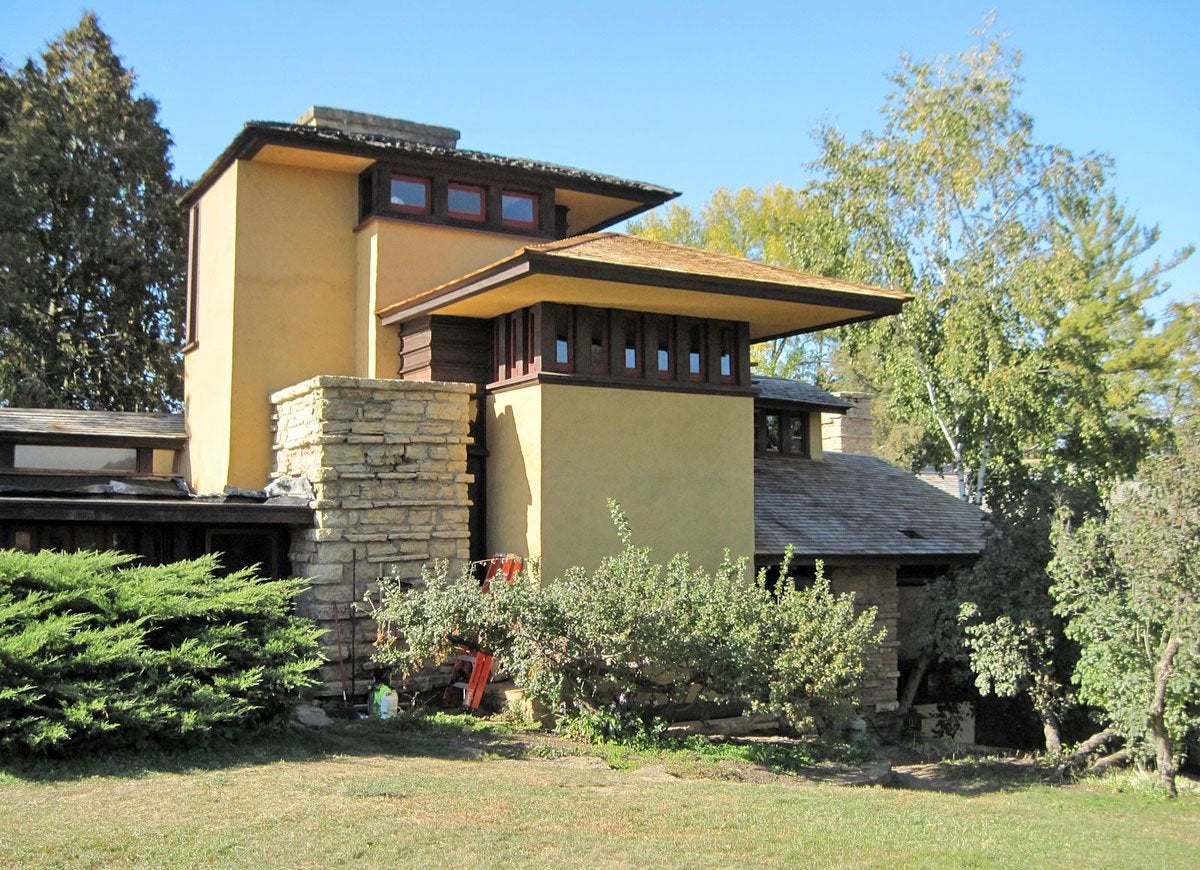
Wikimedia Commons via QuartierLatin1968
Once the estate of architect Frank Lloyd Wright, this 800-acre property served as a center for inspiration and innovation throughout his career. Its legacy is marred, however, by a tragic attack that resulted in the deaths of seven people and the burning of a portion of the house. Wright, who was in Chicago at the time of the incident, would later rebuild the damaged wing of the house.
George Ferris Mansion in Rawlins, Wyoming

flickr.com via Onasill ~ Bill Badzo
This prominent Queen Anne in Rawlins, Wyoming, was built for George and Julia Ferris, who made their fortunes in the copper mining industry. Not long after construction began, George died unexpectedly, leaving Julia to complete the work. While it was beautiful in its day, the home sank into decline after Julia’s death in 1931. It has since been restored and now serves as a bed-and-breakfast that is said to be haunted by the ghost of Julia’s young son.
Related: 18 Victorian Homes We Love
















